Rheological and Microstructural Properties of Oil-in-Water Emulsion Gels Containing Natural Plant Extracts Stabilized with Carboxymethyl Cellulose/Mango (Mangiferaindica) Starch
Abstract
:1. Introduction
2. Materials and Methods
2.1. Chemical Preparation
2.2. Sample Preparation
2.3. Ultrasound-Assisted Extraction of Mango Peel
2.3.1. Determination of Total Phenolic Compounds (TPC) and Antioxidant Activity
2.3.2. GC-MS Analysis
2.4. Extraction of Mango Kernel Starch
Chemical Composition
2.5. Formulation of Emulsion Gels (EGs)
2.5.1. Color Measurement
2.5.2. Dynamic Rheological Characterization
2.5.3. Creep and Recovery Test
2.5.4. Optical Microscopy
2.6. Statistical Analysis
3. Discussion
3.1. Mango Peel Extract
3.2. Mango Kernel Starch
3.3. Emulsion Gel (EG)
3.4. Rheological Properties
Creep and Recovery
3.5. Microstructural Properties
4. Conclusions
Author Contributions
Funding
Acknowledgments
Conflicts of Interest
Appendix A
| RT | Compounds | CAS | %A | %P |
|---|---|---|---|---|
| 4.51 | Pyrogallol | 000087-66-1 | 12.27 | 95 |
| 5.08 | Melezitose | 000084-66-2 | 2.29 | 93 |
| 7.86 | Succinic acid | 1000353-45-5 | 0.03 | 78 |
| 8.53 | Linolelaidic acid | 000506-21-8 | 10.60 | 96 |
| 10.97 | Vitamin A (Retinyl palmitate) | 1000336-23-8 | 0.07 | 87 |
| 20.41 | tocopherol | 007616-22-0 | 1.09 | 99 |
| 21.63 | Vitamin E | 000059-02-9 | 5.17 | 99 |
| 22.91 | Campesterol | 000474-62-4 | 0.93 | 99 |
| 23.42 | Stigmasterol | 000083-48-7 | 1.35 | 99 |
| 24.51 | sitosterol | 000083-47-6 | 0.38 | 99 |
| 25.85 | Lupeol | 000545-47-1 | 2.55 | 95 |
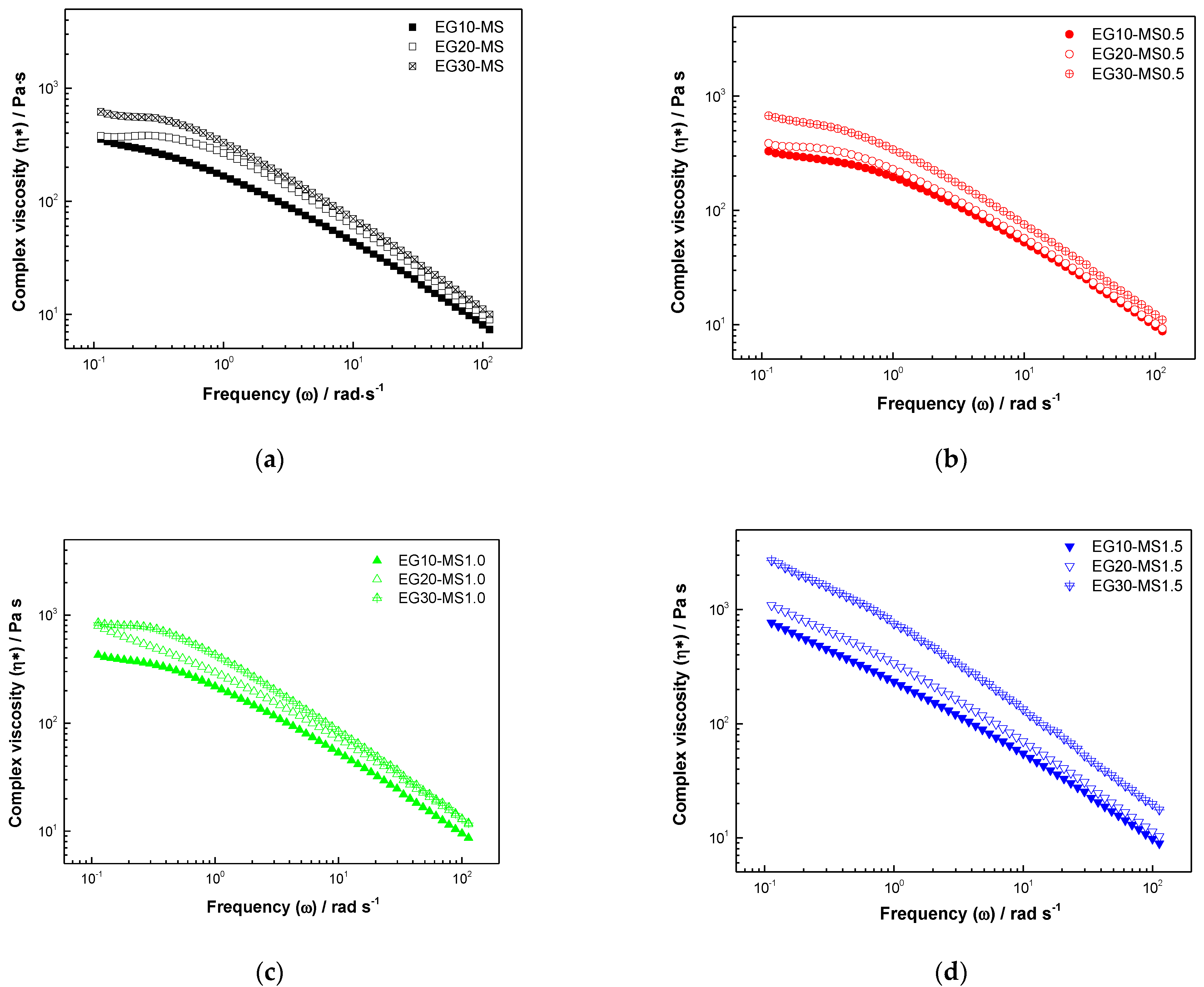
References
- Dickinson, E. Emulsion Gels: The Structuring of Soft Solids with Protein-Stabilized Oil Droplets. Food Hydrocoll. 2012, 28, 224–241. [Google Scholar] [CrossRef]
- Balakrishnan, G.; Nguyen, B.T.; Schmitt, C.; Nicolai, T.; Chassenieux, C. Heat-Set Emulsion Gels of Casein Micelles in Mixtures with Whey Protein Isolate. Food Hydrocoll. 2017, 73, 213–221. [Google Scholar] [CrossRef]
- Dos Santos Pereira, E.; Vinholes, J.R.; Camargo, T.M.; Nora, F.R.; Crizel, R.L.; Chaves, F.; Nora, L.; Vizzotto, M. Characterization of Araçá Fruits (Psidium Cattleianum Sabine): Phenolic Composition, Antioxidant Activity and Inhibition of α-Amylase and α-Glucosidase. Food Biosci. 2020, 37, 100665. [Google Scholar] [CrossRef]
- Hou, J.-J.; Guo, J.; Wang, J.-M.; Yang, X.-Q. Effect of Interfacial Composition and Crumbliness on Aroma Release in Soy Protein/Sugar Beet Pectin Mixed Emulsion Gels. J. Sci. Food Agric. 2016, 96, 4449–4456. [Google Scholar] [CrossRef]
- Cofrades, S.; Bou, R.; Flaiz, L.; Garcimartín, A.; Benedí, J.; Mateos, R.; Sánchez-Muniz, F.J.; Olivero-David, R.; Jiménez-Colmenero, F. Bioaccessibility of Hydroxytyrosol and N-3 Fatty Acids as Affected by the Delivery System: Simple, Double and Gelled Double Emulsions. J. Food Sci. Technol. 2017, 54, 1785–1793. [Google Scholar] [CrossRef] [PubMed]
- Ma, L.; Wan, Z.; Yang, X. Multiple Water-in-Oil-in-Water Emulsion Gels Based on Self-Assembled Saponin Fibrillar Network for Photosensitive Cargo Protection. J. Agric. Food Chem. 2017, 65, 9735–9743. [Google Scholar] [CrossRef]
- Quintana, S.E.; Llalla, O.; García-Zapateiro, L.A.; García-Risco, M.R.; Fornari, T. Preparation and Characterization of Licorice-Chitosan Coatings for Postharvest Treatment of Fresh Strawberries. Appl. Sci. 2020, 10, 8431. [Google Scholar] [CrossRef]
- Quintana, S.E.; Llalla, O.; García-Risco, M.R.; Fornari, T. Comparison between Essential Oils and Supercritical Extracts into Chitosan-Based Edible Coatings on Strawberry Quality during Cold Storage. J. Supercrit. Fluids 2021, 171, 105198. [Google Scholar] [CrossRef]
- Alañón, M.E.; Oliver-Simancas, R.; Gómez-Caravaca, A.M.; Arráez-Román, D.; Segura-Carretero, A. Evolution of Bioactive Compounds of Three Mango Cultivars (Mangifera Indica L.) at Different Maturation Stages Analyzed by HPLC-DAD-q-TOF-MS. Food Res. Int. 2019, 125, 108526. [Google Scholar] [CrossRef] [PubMed]
- Quintana, S.E.; Salas, S.; García-Zapateiro, L.A. Bioactive Compounds of Mango (Mangifera Indica): A Review of Extraction Technologies and Chemical Constituents. J. Sci. Food Agric. 2021, 1–7. [Google Scholar] [CrossRef]
- Marcillo-Parra, V.; Anaguano, M.; Molina, M.; Tupuna-Yerovi, D.S.; Ruales, J. Characterization and Quantification of Bioactive Compounds and Antioxidant Activity in Three Different Varieties of Mango (Mangifera Indica L.) Peel from the Ecuadorian Region Using HPLC-UV/VIS and UPLC-PDA. NFS J. 2021, 23, 1–7. [Google Scholar] [CrossRef]
- Fang, Z.; Bhandari, B. Encapsulation of Polyphenols—A Review. Trends Food Sci. Technol. 2010, 21, 510–523. [Google Scholar] [CrossRef]
- Binks, B.P.; Lumsdon, S.O. Effects of Oil Type and Aqueous Phase Composition on Oil-Water Mixtures Containing Particles of Intermediate Hydrophobicity. Phys. Chem. Chem. Phys. 2000, 2, 2959–2967. [Google Scholar] [CrossRef]
- Li, A.; Gong, T.; Hou, Y.; Yang, X.; Guo, Y. Alginate-Stabilized Thixotropic Emulsion Gels and Their Applications in Fabrication of Low-Fat Mayonnaise Alternatives. Int. J. Biol. Macromol. 2020, 146, 821–831. [Google Scholar] [CrossRef] [PubMed]
- Herrero, A.M.; Ruiz-Capillas, C.; Pintado, T.; Carmona, P.; Jiménez-Colmenero, F. Elucidation of Lipid Structural Characteristics of Chia Oil Emulsion Gels by Raman Spectroscopy and Their Relationship with Technological Properties. Food Hydrocoll. 2018, 77, 212–219. [Google Scholar] [CrossRef]
- Orgulloso-Bautista, S.; Ortega-Toro, R.; Alberto, L.; Zapateiro, G. Design and Application of Hydrocolloids from Butternut Squash (Cucurbita Moschata) Epidermis as a Food Additive in Mayonnaise-Type Sauces. ACS Omega 2021, 6, 5499–5508. [Google Scholar] [CrossRef]
- Saha, D.; Bhattacharya, S. Hydrocolloids as Thickening and Gelling Agents in Food: A Critical Review. J. Food Sci. Technol. 2010, 47, 587. [Google Scholar] [CrossRef] [PubMed] [Green Version]
- Copetti, G.; Grassi, M.; Lapasin, R.; Pricl, S. Synergistic Gelation of Xanthan Gum with Locust Bean Gum: A Rheological Investigation. Glycoconj. J. 1997, 14, 951–961. [Google Scholar] [CrossRef]
- Nor Hayati, I.; Che Man, Y.B.; Tan, C.P.; Nor Aini, I. Droplet Characterization and Stability of Soybean Oil/Palm Kernel Olein O/W Emulsions with the Presence of Selected Polysaccharides. Food Hydrocoll. 2009, 23, 233–243. [Google Scholar] [CrossRef]
- Sharma, B.R.; Dhuldhoya, N.C.; Merchant, S.U.; Merchant, U.C. Hydrocolloids: Efficient Rheology Control Additives. Sci. Technol. Entrep. 2007, 2, 1–9. [Google Scholar]
- Dickinson, E. Hydrocolloids Acting as Emulsifying Agents—How Do They Do It? Food Hydrocoll. 2018, 78, 2–14. [Google Scholar] [CrossRef]
- Mantelet, M.; Panouillé, M.; Boué, F.; Bosc, V.; Restagno, F.; Souchon, I.; Mathieu, V. Impact of Sol-Gel Transition on the Ultrasonic Properties of Complex Model Foods: Application to Agar/Gelatin Gels and Emulsion Filled Gels. Food Hydrocoll. 2019, 87, 506–518. [Google Scholar] [CrossRef]
- Lastra-Ripoll, S.E.; Quintana-Martinez, S.E.; Garcia-Zapateiro, L.A. Rheological and Microstructural Properties of Xanthan Gum-Based Coating Solutions Enriched with Phenolic Mango (Mangifera Indica L.) Peel Extracts. ACS Omega 2021, 6, 16119–16128. [Google Scholar] [CrossRef] [PubMed]
- Singleton, V.L.; Orthofer, R.; Lamuela-Raventós, R.M. [14] Analysis of total phenols and other oxidation substrates and antioxidants by means of folin-ciocalteu reagent. In Oxidants and Antioxidants Part A; Academic Press: Cambridge, MA, USA, 1999; Volume 299, pp. 152–178. ISBN 00766879. [Google Scholar]
- Re, R.; Pellegrini, N.; Proteggente, A.; Pannala, A.; Yang, M.; Rice-Evans, C. Antioxidant Activity Applying an Improved Abts Radical Cation Decolorization Assay. Free Radic. Biol. Med. 1999, 26, 1231–1237. [Google Scholar] [CrossRef]
- Kaur, M.; Singh, N.; Sandhu, K.S.; Guraya, H.S. Physicochemical, Morphological, Thermal and Rheological Properties of Starches Separated from Kernels of Some Indian Mango Cultivars (Mangifera Indica L.). Food Chem. 2004, 85, 131–140. [Google Scholar] [CrossRef]
- AOAC. Association of Official Analytical Chemist Official Methods of Analysis, 17th ed.; AOAC: Gaithersburg, MD, USA, 2000. [Google Scholar]
- Morrison, W.R.; Laignelet, B. An Improved Colorimetric Procedure for Determining Apparent and Total Amylose in Cereal and Other Starches. J. Cereal Sci. 1983, 1, 9–20. [Google Scholar] [CrossRef]
- Shi, Z.; Shi, Z.; Wu, M.; Shen, Y.; Li, G.; Ma, T. Fabrication of Emulsion Gel Based on Polymer Sanxan and Its Potential as a Sustained-Release Delivery System for β-Carotene. Int. J. Biol. Macromol. 2020, 164, 597–605. [Google Scholar] [CrossRef] [PubMed]
- Mennen, L.I.; Walker, R.; Bennetau-Pelissero, C.; Scalbert, A. Risks and Safety of Polyphenol Consumption. Am. J. Clin. Nutr. 2005, 81, 326S–329S. [Google Scholar] [CrossRef] [Green Version]
- Williamson, G.; Holst, B. Dietary Reference Intake (DRI) Value for Dietary Polyphenols: Are We Heading in the Right Direction? Br. J. Nutr. 2008, 99, S55–S58. [Google Scholar] [CrossRef] [Green Version]
- Li, L.; Liu, G.; Lin, Y. Physical and Bloom Stability of Low-Saturation Chocolates with Oleogels Based on Different Gelation Mechanisms. LWT 2021, 140, 110807. [Google Scholar] [CrossRef]
- Augusto, P.E.D.; Ibarz, A.; Cristianini, M. Effect of High Pressure Homogenization (HPH) on the Rheological Properties of Tomato Juice: Viscoelastic Properties and the Cox–Merz Rule. J. Food Eng. 2013, 114, 57–63. [Google Scholar] [CrossRef] [Green Version]
- Steffe, J. Rheological Methods in Food Process Engineering; Freeman Press: East Lansing, MI, USA, 1996; ISBN 0963203614. [Google Scholar]
- Gharibzahedi, S.M.T.; Smith, B.; Guo, Y. Ultrasound-Microwave Assisted Extraction of Pectin from Fig (Ficus Carica L.) Skin: Optimization, Characterization and Bioactivity. Carbohydr. Polym. 2019, 222, 114992. [Google Scholar] [CrossRef] [PubMed]
- Pinelo, M.; Sineiro, J. Mass Transfer during Continuous Solid—Liquid Extraction of Antioxidants from Grape Byproducts. J. Food Eng. 2006, 77, 57–63. [Google Scholar] [CrossRef]
- Zou, T.B.; Xia, E.Q.; He, T.P.; Huang, M.Y.; Jia, Q.; Li, H.W. Ultrasound-Assisted Extraction of Mangiferin from Mango (Mangifera Indica L.) Leaves Using Response Surface Methodology. Molecules 2014, 19, 1411–1421. [Google Scholar] [CrossRef] [PubMed]
- Dorta, E.; Lobo, M.G.; González, M. Using Drying Treatments to Stabilise Mango Peel and Seed: Effect on Antioxidant Activity. LWT-Food Sci. Technol. 2012, 45, 261–268. [Google Scholar] [CrossRef]
- Guandalini, B.B.V.; Rodrigues, N.P.; Marczak, L.D.F. Sequential Extraction of Phenolics and Pectin from Mango Peel Assisted by Ultrasound. Food Res. Int. 2019, 119, 455–461. [Google Scholar] [CrossRef]
- Adilah, A.N.; Jamilah, B.; Noranizan, M.A.; Hanani, Z.A.N. Utilization of Mango Peel Extracts on the Biodegradable Films for Active Packaging. Food Packag. Shelf Life 2018, 16, 1–7. [Google Scholar] [CrossRef]
- Dorta, E.; González, M.; Lobo, M.G.; Sánchez-Moreno, C.; de Ancos, B. Screening of Phenolic Compounds in By-Product Extracts from Mangoes (Mangifera Indica L.) by HPLC-ESI-QTOF-MS and Multivariate Analysis for Use as a Food Ingredient. Food Res. Int. 2014, 57, 51–60. [Google Scholar] [CrossRef] [Green Version]
- Jahurul, M.H.A.; Zaidul, I.S.M.; Ghafoor, K.; Al-Juhaimi, F.Y.; Nyam, K.L.; Norulaini, N.A.N.; Sahena, F.; Mohd Omar, A.K. Mango (Mangifera Indica L.) by-Products and Their Valuable Components: A Review. Food Chem. 2015, 183, 173–180. [Google Scholar] [CrossRef]
- Martínez-Ramos, T.; Benedito-Fort, J.; Watson, N.J.; Ruiz-López, I.I.; Che-Galicia, G.; Corona-Jiménez, E. Effect of Solvent Composition and Its Interaction with Ultrasonic Energy on the Ultrasound-Assisted Extraction of Phenolic Compounds from Mango Peels (Mangifera Indica L.). Food Bioprod. Process. 2020, 122, 41–54. [Google Scholar] [CrossRef]
- López-Cobo, A.; Verardo, V.; Diaz-de-Cerio, E.; Segura-Carretero, A.; Fernández-Gutiérrez, A.; Gómez-Caravaca, A.M. Use of HPLC- and GC-QTOF to Determine Hydrophilic and Lipophilic Phenols in Mango Fruit (Mangifera Indica L.) and Its by-Products. Food Res. Int. 2017, 100, 423–434. [Google Scholar] [CrossRef]
- De Felipe, F.L.; de las Rivas, B.; Muñoz, R. Bioactive Compounds Produced by Gut Microbial Tannase: Implications for Colorectal Cancer Development. Front. Microbiol. 2014, 5, 684. [Google Scholar] [CrossRef]
- Duvivier, P.; Hsieh, P.; Lai, P.; Charle, A. Retention of Phenolics, Carotenoids, and Antioxidant Activity in the Taiwanese Sweet Potato (Ipomoea Batatas Lam.) CV Tainong 66 Subjected to Different Drying Conditions. Afr. J. Food Agric. Nutr. Dev. 2011, 10. [Google Scholar] [CrossRef]
- Bharti, I.; Singh, S.; Saxena, D.C. Exploring the Influence of Heat Moisture Treatment on Physicochemical, Pasting, Structural and Morphological Properties of Mango Kernel Starches from Indian Cultivars. LWT 2019, 110, 197–206. [Google Scholar] [CrossRef]
- Patiño-Rodríguez, O.; Agama-Acevedo, E.; Ramos-Lopez, G.; Bello-Pérez, L.A. Unripe Mango Kernel Starch: Partial Characterization. Food Hydrocoll. 2020, 101, 105512. [Google Scholar] [CrossRef]
- Baldwin, P.M. Starch Granule-Associated Proteins and Polypeptides: A Review. Starch/Staerke 2001, 53, 475–503. [Google Scholar] [CrossRef]
- Punia, S.; Kumar, M.; Siroha, A.K.; Kennedy, J.F.; Dhull, S.B.; Whiteside, W.S. Pearl Millet Grain as an Emerging Source of Starch: A Review on Its Structure, Physicochemical Properties, Functionalization, and Industrial Applications. Carbohydr. Polym. 2021, 260, 117776. [Google Scholar] [CrossRef] [PubMed]
- Tagliapietra, B.L.; Felisberto, M.H.F.; Sanches, E.A.; Campelo, P.H.; Clerici, M.T.P.S. Non-Conventional Starch Sources. Curr. Opin. Food Sci. 2021, 39, 93–102. [Google Scholar] [CrossRef]
- Lemos, P.V.F.; Barbosa, L.S.; Ramos, I.G.; Coelho, R.E.; Druzian, J.I. Characterization of Amylose and Amylopectin Fractions Separated from Potato, Banana, Corn, and Cassava Starches. Int. J. Biol. Macromol. 2019, 132, 32–42. [Google Scholar] [CrossRef]
- Tester, R.F.; Karkalas, J.; Qi, X. Starch—Composition, Fine Structure and Architecture. J. Cereal Sci. 2004, 39, 151–165. [Google Scholar] [CrossRef]
- Sandhu, K.S.; Lim, S.T. Structural Characteristics and in Vitro Digestibility of Mango Kernel Starches (Mangifera Indica L.). Food Chem. 2008, 107, 92–97. [Google Scholar] [CrossRef]
- Guo, K.; Lin, L.; Fan, X.; Zhang, L.; Wei, C. Comparison of Structural and Functional Properties of Starches from Five Fruit Kernels. Food Chem. 2018, 257, 75–82. [Google Scholar] [CrossRef] [PubMed]
- Hernández-Medina, M.; Torruco-Uco, J.G.; Chel-Guerrero, L.; Betancur-Ancona, D. Caracterización Fisicoquímica de Almidones de Tubérculos Cultivados En Yucatán, México. Ciência E Tecnol. Aliment. 2008, 28, 718–726. [Google Scholar] [CrossRef] [Green Version]
- Tian, S.; Sun, Y. Influencing Factor of Resistant Starch Formation and Application in Cereal Products: A Review. Int. J. Biol. Macromol. 2020, 149, 424–431. [Google Scholar] [CrossRef]
- Samee, M.; Yasin, M.R.; Fatima, S.; Rauf, A.; Naz, S.; Mahpara Gilani, M.T. Comparative Study of Proximate Composition and Mineral Contents in Ctenopharyngoden Idella and Rita Rita Collected from River Chenab. Int. J. Biosci. IJB 2018, 13, 29–37. [Google Scholar]
- Liang, X.; Ma, C.; Yan, X.; Zeng, H.; McClements, D.J.; Liu, X.; Liu, F. Structure, Rheology and Functionality of Whey Protein Emulsion Gels: Effects of Double Cross-Linking with Transglutaminase and Calcium Ions. Food Hydrocoll. 2020, 102, 105569. [Google Scholar] [CrossRef]
- Heydari, A.; Razavi, S.M.A. Evaluating High Pressure-Treated Corn and Waxy Corn Starches as Novel Fat Replacers in Model Low-Fat O/W Emulsions: A Physical and Rheological Study. Int. J. Biol. Macromol. 2021, 184, 393–404. [Google Scholar] [CrossRef]
- Javidi, F.; Razavi, S.M.A.; Mohammad Amini, A. Cornstarch Nanocrystals as a Potential Fat Replacer in Reduced Fat O/W Emulsions: A Rheological and Physical Study. Food Hydrocoll. 2019, 90, 172–181. [Google Scholar] [CrossRef]
- Li, S.; Zhang, B.; Li, C.; Fu, X.; Huang, Q. Pickering Emulsion Gel Stabilized by Octenylsuccinate Quinoa Starch Granule as Lutein Carrier: Role of the Gel Network. Food Chem. 2020, 305, 125476. [Google Scholar] [CrossRef]
- Farjami, T.; Madadlou, A. An Overview on Preparation of Emulsion-Filled Gels and Emulsion Particulate Gels. Trends Food Sci. Technol. 2019, 86, 85–94. [Google Scholar] [CrossRef]
- Kokini, J.; van Aken, G. Discussion Session on Food Emulsions and Foams. Food Hydrocoll. 2006, 20, 438–445. [Google Scholar] [CrossRef]
- Winter, H.H.; Chambon, F. Analysis of Linear Viscoelasticity of a Crosslinking Polymer at the Gel Point. J. Rheol. 1986, 30, 367–382. [Google Scholar] [CrossRef]
- Li, Q.; Xu, M.; Xie, J.; Su, E.; Wan, Z.; Sagis, L.M.C.; Yang, X. Large Amplitude Oscillatory Shear (LAOS) for Nonlinear Rheological Behavior of Heterogeneous Emulsion Gels Made from Natural Supramolecular Gelators. Food Res. Int. 2021, 140, 110076. [Google Scholar] [CrossRef]
- Lu, S.; Yang, Y.; Yao, J.; Shao, Z.; Chen, X. Exploration of the Nature of a Unique Natural Polymer-Based Thermosensitive Hydrogel. Soft Matter 2015, 12, 492–499. [Google Scholar] [CrossRef] [PubMed]
- Xu, Q.; Qi, B.; Han, L.; Wang, D.; Zhang, S.; Jiang, L.; Xie, F.; Li, Y. Study on the Gel Properties, Interactions, and PH Stability of Pea Protein Isolate Emulsion Gels as Influenced by Inulin. LWT 2021, 137, 110421. [Google Scholar] [CrossRef]
- Zhang, Y.; Yang, H.; Zheng, H.; Yuan, D.; Mao, L. Physical Properties and Salt Release of Potato Starch-Based Emulsion Gels with OSA Starch-Stabilized Oil Droplets. LWT 2021, 141, 110929. [Google Scholar] [CrossRef]
- Shahbazi, M.; Jäger, H.; Ettelaie, R. Application of Pickering Emulsions in 3D Printing of Personalized Nutrition. Part I: Development of Reduced-Fat Printable Casein-Based Ink. Colloids Surf. A Physicochem. Eng. Asp. 2021, 622, 126641. [Google Scholar] [CrossRef]
- Rubinstein, M.; Dobrynin, A.V. Associations Leading to Formation of Reversible Networks and Gels. Curr. Opin. Colloid Interface Sci. 1999, 4, 83–87. [Google Scholar] [CrossRef]
- Martins, A.J.; Vicente, A.A.; Cunha, R.L.; Cerqueira, M.A. Edible Oleogels: An Opportunity for Fat Replacement in Foods. Food Funct. 2018, 9, 758–773. [Google Scholar] [CrossRef] [PubMed]
- Chang, Y.Y.; Li, D.; Wang, L.J.; Bi, C.H.; Adhikari, B. Effect of Gums on the Rheological Characteristics and Microstructure of Acid-Induced SPI-Gum Mixed Gels. Carbohydr. Polym. 2014, 108, 183–191. [Google Scholar] [CrossRef] [PubMed]
- Lin, D.; Kelly, A.L.; Miao, S. Preparation, Structure-Property Relationships and Applications of Different Emulsion Gels: Bulk Emulsion Gels, Emulsion Gel Particles, and Fluid Emulsion Gels. Trends Food Sci. Technol. 2020, 102, 123–137. [Google Scholar] [CrossRef]
- Su, D.; Zhu, X.; Adhikari, B.; Li, D.; Wang, L. Effect of High-Pressure Homogenization on the Rheology, Microstructure and Fractal Dimension of Citrus Fiber-Oil Dispersions. J. Food Eng. 2020, 277, 109899. [Google Scholar] [CrossRef]
- Miao, J.; Xu, N.; Cheng, C.; Zou, L.; Chen, J.; Wang, Y.; Liang, R.; McClements, D.J.; Liu, W. Fabrication of Polysaccharide-Based High Internal Phase Emulsion Gels: Enhancement of Curcumin Stability and Bioaccessibility. Food Hydrocoll. 2021, 117, 106679. [Google Scholar] [CrossRef]
- Qi, F.; Wu, J.; Sun, G.; Nan, F.; Ngai, T.; Ma, G. Systematic Studies of Pickering Emulsions Stabilized by Uniform-Sized PLGA Particles: Preparation and Stabilization Mechanism. J. Mater. Chem. B 2014, 2, 7605–7611. [Google Scholar] [CrossRef] [PubMed]
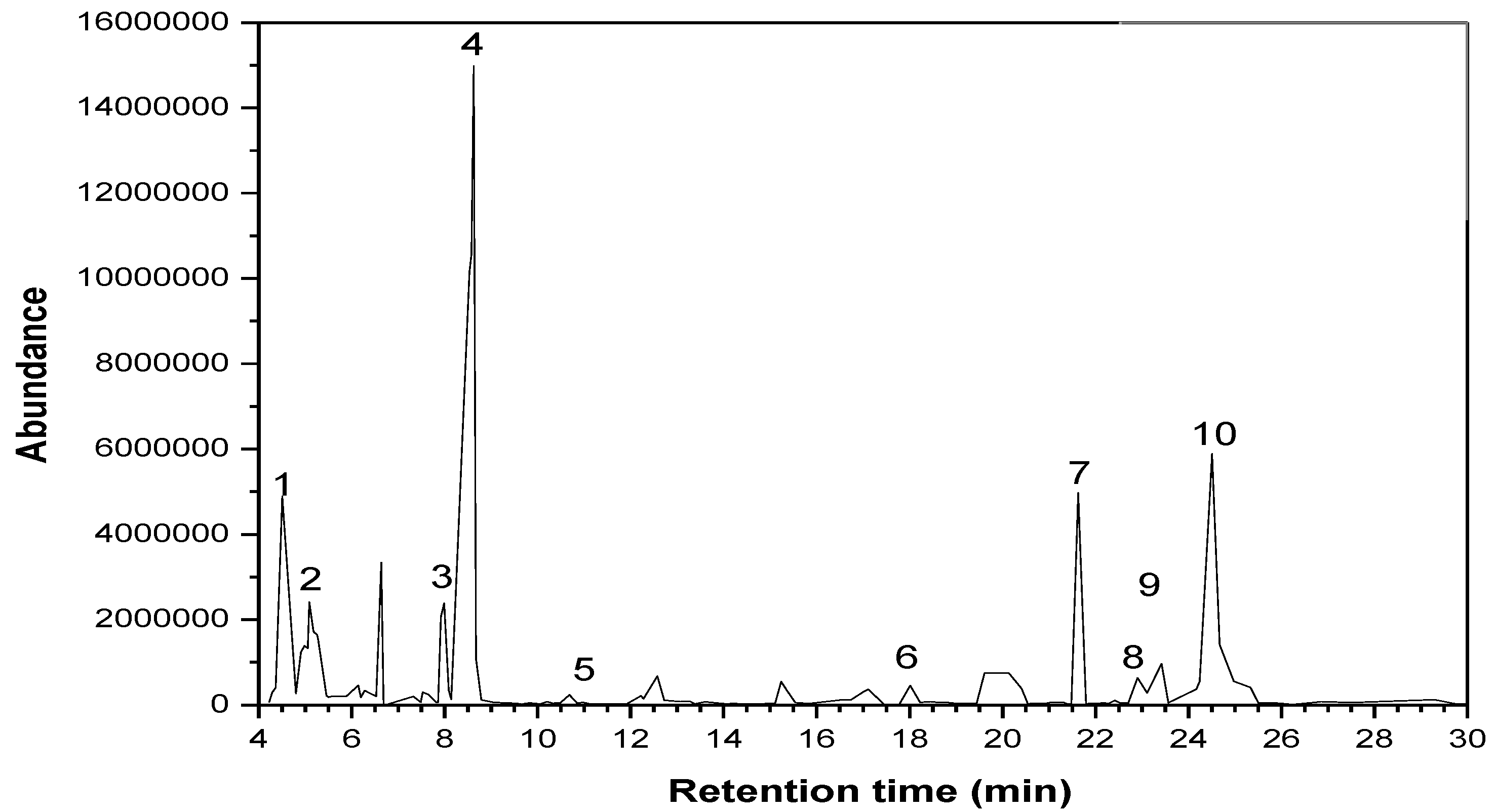
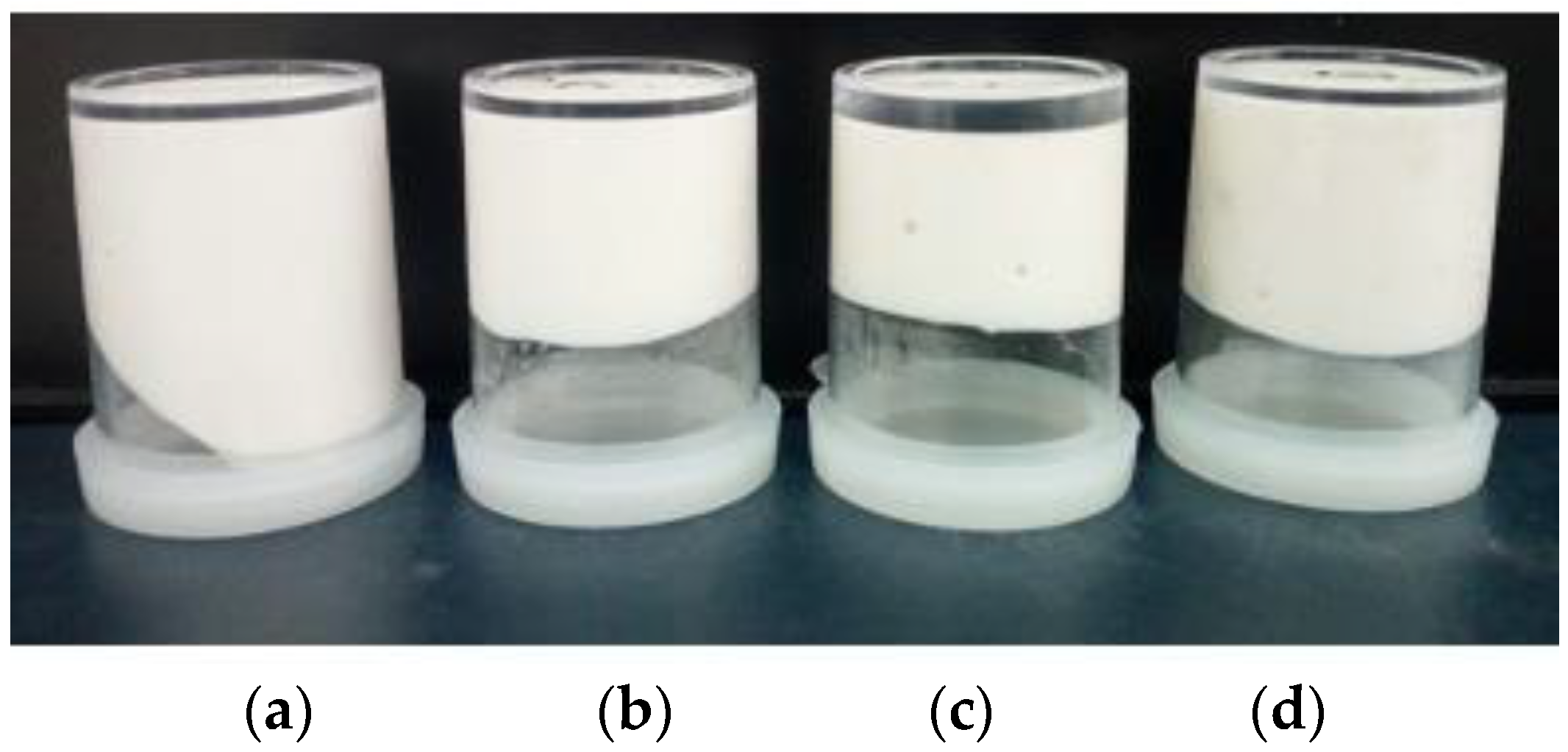
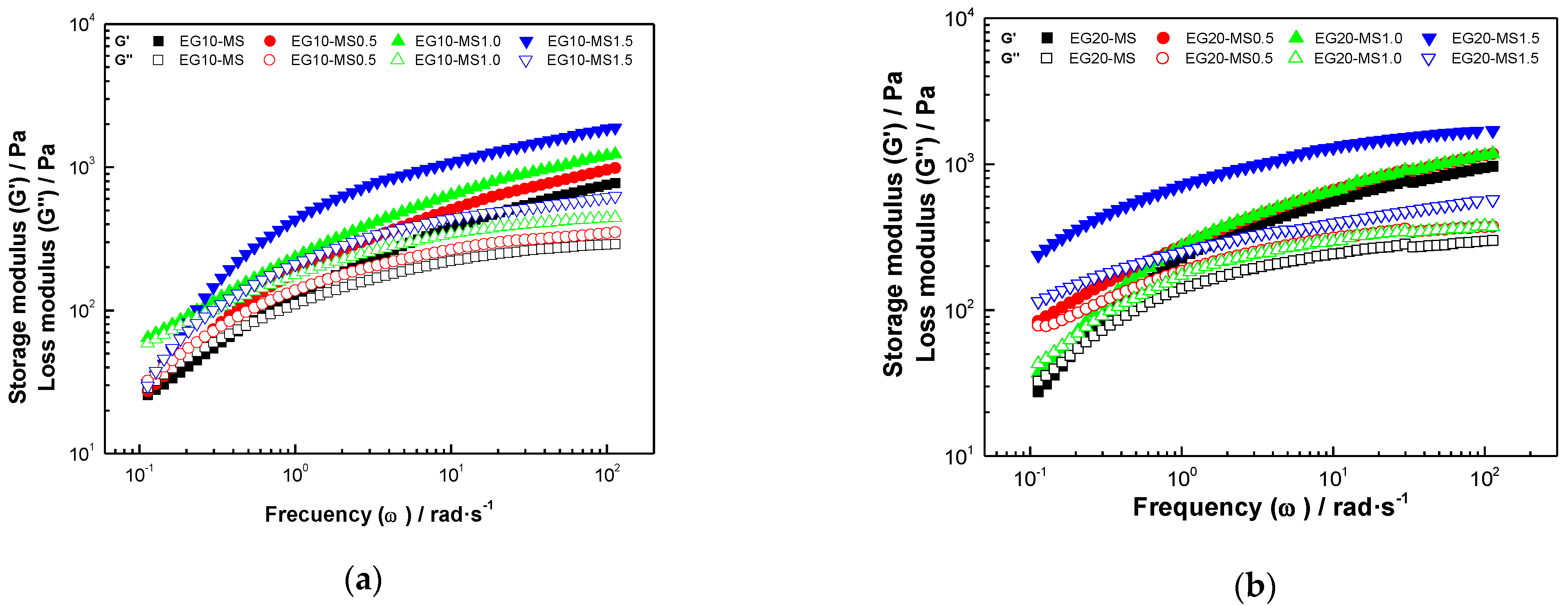
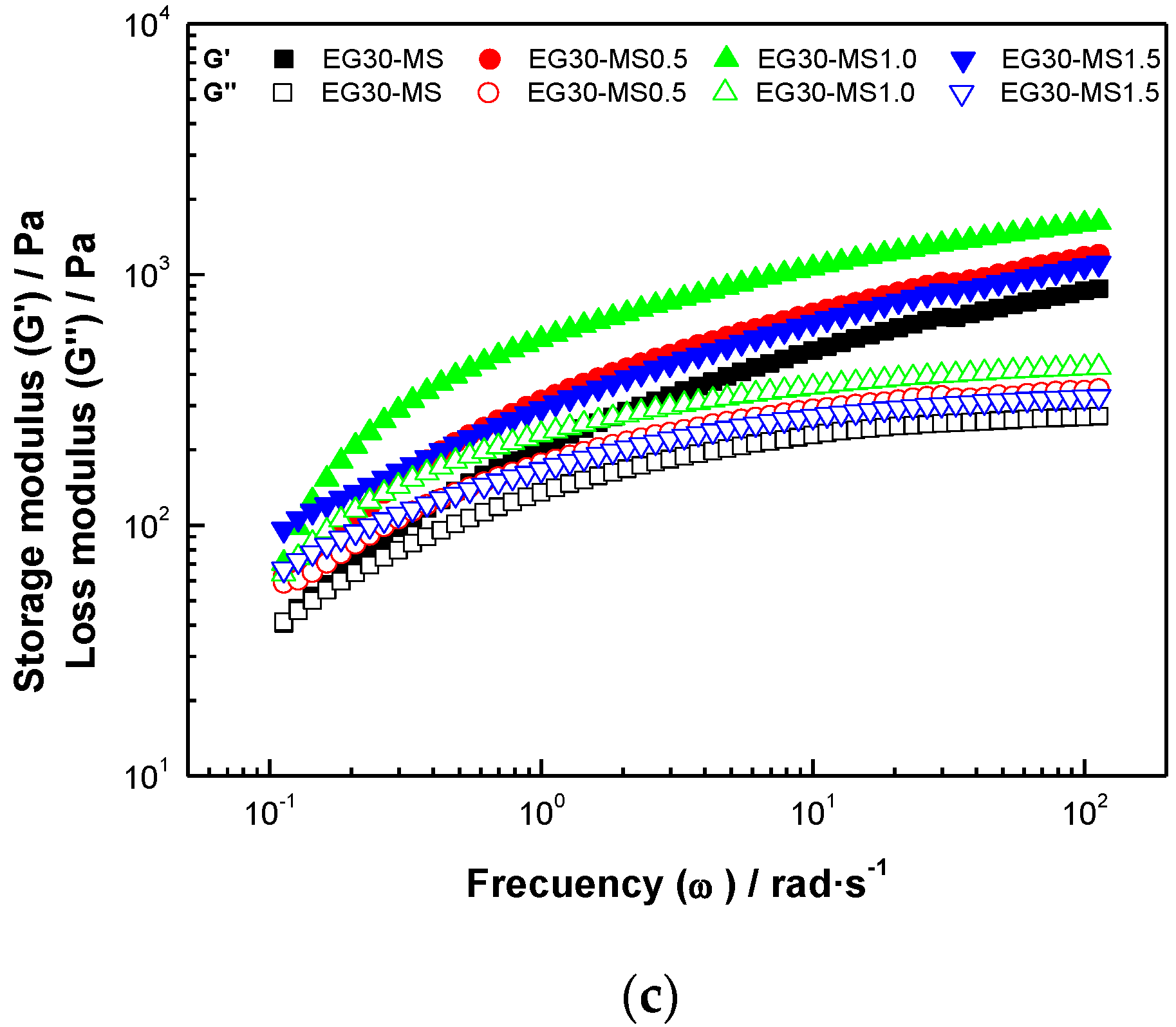
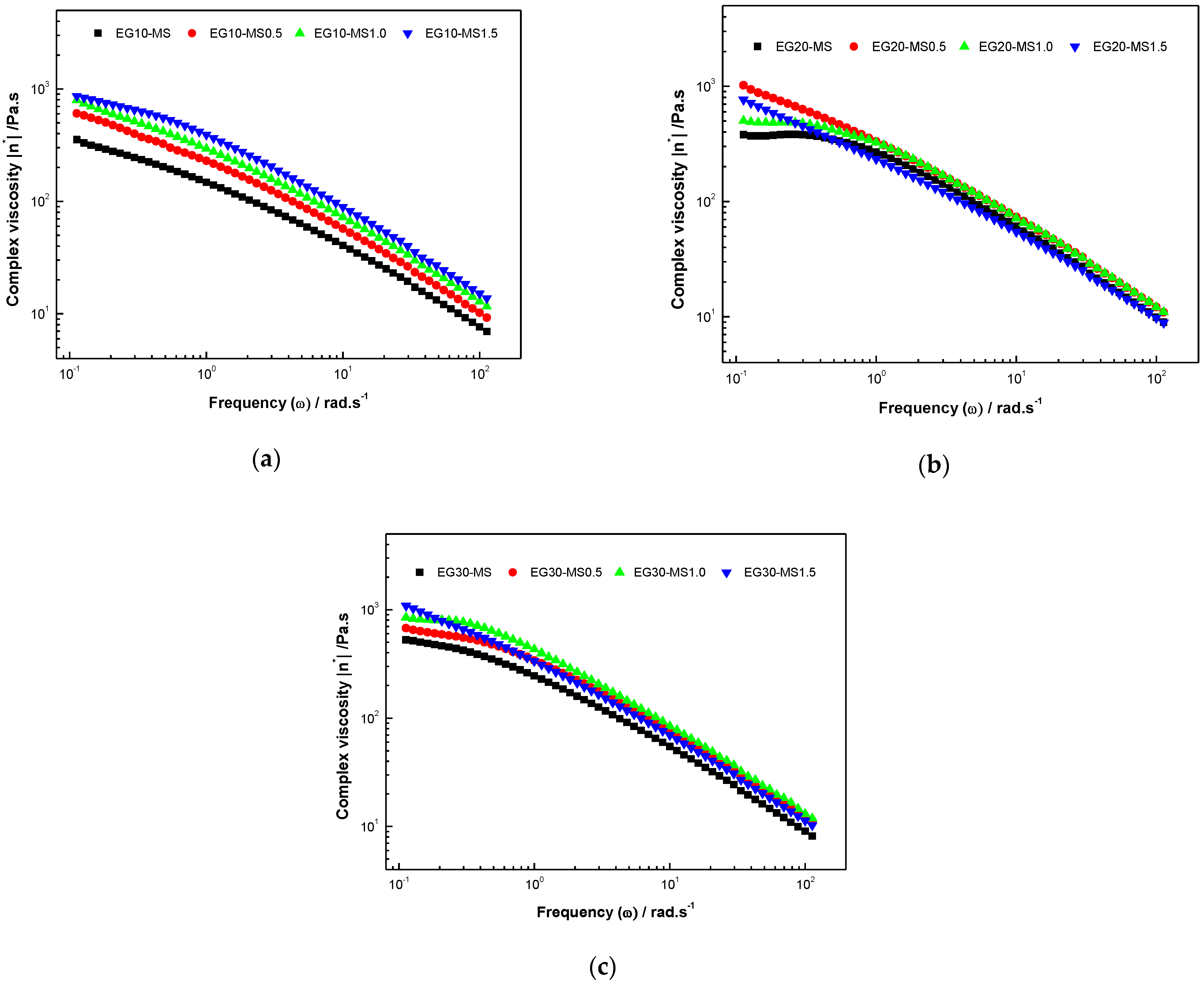
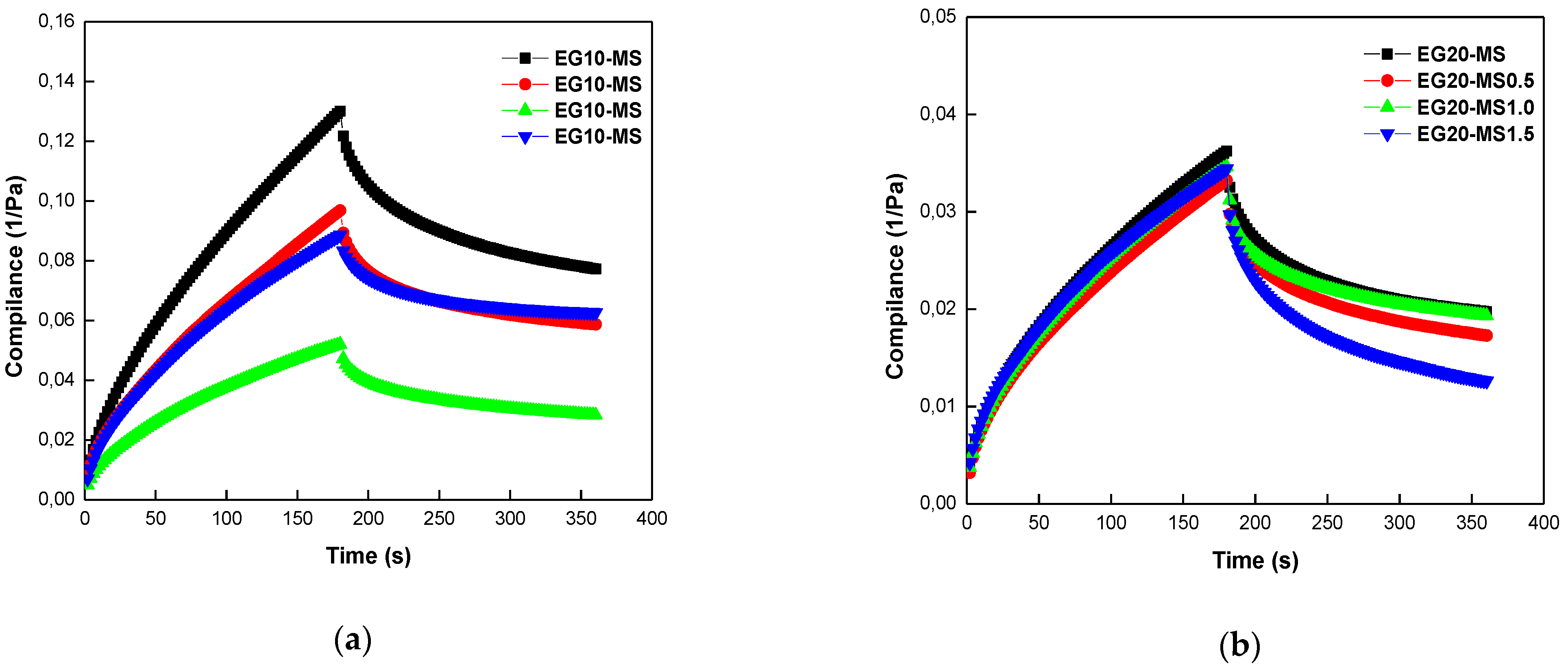
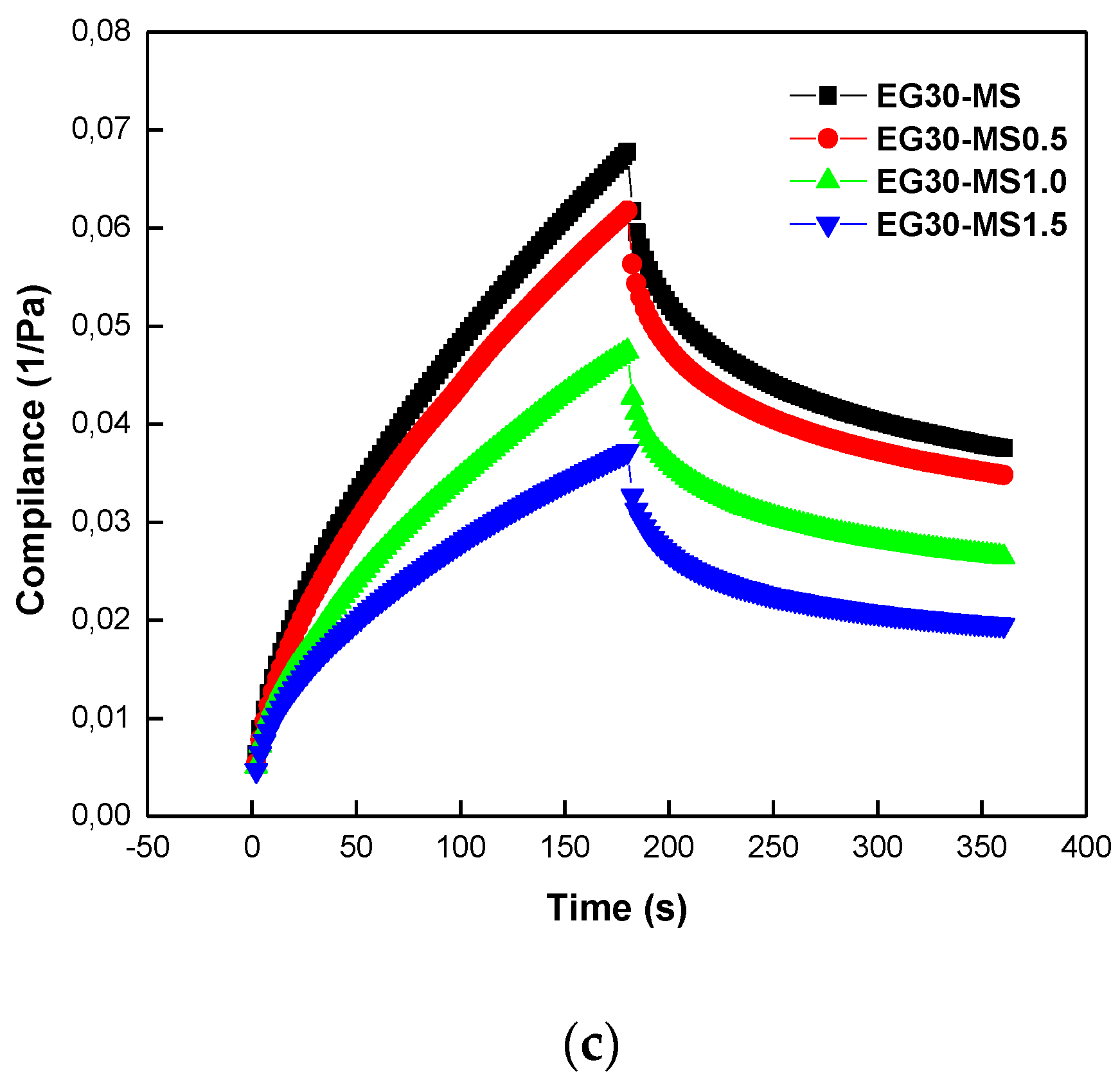


| Sample Code | Canola Oil % | Water % | Mango Starch % | CMC % | Tween 80 % | Mango Peel Extract % |
|---|---|---|---|---|---|---|
| EG10-MS | 10 | 90 | 0 | 3 | 0.5 | 1 |
| EG10-MS0.5 | 10 | 90 | 0.5 | 3 | 0.5 | 1 |
| EG10-MS1.0 | 10 | 90 | 1 | 3 | 0.5 | 1 |
| EG10-MS1.5 | 10 | 90 | 1.5 | 3 | 0.5 | 1 |
| EG20-MS | 20 | 80 | 0 | 3 | 0.5 | 1 |
| EG20-MS0.5 | 20 | 80 | 0.5 | 3 | 0.5 | 1 |
| EG20-MS1.0 | 20 | 80 | 1 | 3 | 0.5 | 1 |
| EG20-MS1.5 | 20 | 80 | 1.5 | 3 | 0.5 | 1 |
| EG30-MS | 30 | 70 | 0 | 3 | 0.5 | 1 |
| EG30-MS0.5 | 30 | 70 | 0.5 | 3 | 0.5 | 1 |
| EG30-MS1.0 | 30 | 70 | 1 | 3 | 0.5 | 1 |
| EG30-MS1.5 | 30 | 70 | 1.5 | 3 | 0.5 | 1 |
| Sample Code | L* | WI | ∆E |
|---|---|---|---|
| EG10-MS | 90.79 ± 3.85 ab | 83.92 ± 0.29 a | - |
| EG10-MS0.5 | 77.49 ± 6.17 def | 75.56 ± 5.91 acd | 14.57 ± 5.10 ab |
| EG10-MS1.0 | 71.18 ± 2.36 fg | 68.88 ± 0.88 de | 20.09 ± 2.56 abc |
| EG10-MS1.5 | 74.12 ± 12.26 efg | 70.95 ± 12.22 cde | 17.37 ± 11.62 ab |
| EG20-MS | 83.09 ± 0.53 cd | 79.39 ± 0.60 ab | - |
| EG20-MS0.5 | 78.42 ± 0.77 cde | 77.58 ± 0.80 abc | 7.48 ± 0.49 cd |
| EG20-MS1.0 | 74.41 ± 1.76 efg | 71.96 ± 2.64 cde | 9.50 ± 1.77 cd |
| EG20-MS1.5 | 71.34 ± 0.48 efg | 66.12 ± 0.66 ef | 13.47 ± 0.65 bcd |
| EG30-MS | 60.99 ± 1.15 h | 59.72 ± 0.96 f | - |
| EG30-MS0.5 | 96.01 ± 0.24 a | 93.58 ± 0.33 g | 32.00 ± 0.21 e |
| EG30-MS1.0 | 70.08 ± 1.41 g | 68.78 ± 1.63 de | 6.04 ± 1.53 d |
| EG30-MS1.5 | 85.32 ± 0.61 bc | ± 0.34 a | 21.15 ± 0.59 a |
| Sample Code | R2 | R2 | |||||
|---|---|---|---|---|---|---|---|
| EG10-MS | 147.32 ± 4.68 a | 0.36 ± 0.01 a | 0.98 | 114.16 ± 3.83 a | 0.22 ± 0.01 ab | 0.92 | 167.2 ± 2.34 |
| EG10-MS0.5 | 205.93 ± 6.92 b | 0.34 ± 0.01 a | 0.97 | 139.20 ± 4.78 b | 0.22 ± 0.01 ab | 0.92 | 196.2 ± 2.52 |
| EG10-MS1.0 | 267.13 ± 7.58 d | 0.34 ± 0.02 a | 0.98 | 181.60 ± 5.44 c | 0.21 ± 0.02 bc | 0.93 | 219.4 ± 1.24 |
| EG10-MS1.5 | 463.54 ± 18.61 g | 0.31 ± 0.01 b | 0.95 | 215.90 ± 7.94 d | 0.24 ± 0.01 a | 0.93 | 336.8 ± 2.43 |
| EG20-MS | 243.69 ± 9.20 c | 0.31 ± 0.01 b | 0.96 | 134.82 ± 4.73 b | 0.19 ± 0.01 bcd | 0.88 | 245.6 ± 1.65 |
| EG20-MS0.5 | 257.61 ± 3.38 cd | 0.35 ± 0.02 a | 0.96 | 184.36 ± 5.02 c | 0.17 ± 0.01 ef | 0.90 | 331.8 ± 2.63 |
| EG20-MS1.0 | 289.51 ± 10.14 e | 0.31 ± 0.01 b | 0.96 | 167.06 ± 5.66 e | 0.20 ± 0.01 bcd | 0.89 | 294.1 ± 1.74 |
| EG20-MS1.5 | 715.54 ± 18.52 i | 0.21 ± 0.01 c | 0.94 | 244.40 ± 3.19 f | 0.19 ± 0.01 cde | 0.97 | 439.5 ± 1.52 |
| EG30-MS | 220.96 ± 6.71 b | 0.31 ± 0.02 b | 0.97 | 132.38 ± 4.00 b | 0.18 ± 0.02 def | 0.89 | 267.4 ± 2.78 |
| EG30-MS0.5 | 307.98 ± 6.92 ef | 0.28 ± 0.01 d | 0.98 | 165.51 ± 3.94 e | 0.17 ± 0.01 ef | 0.91 | 341.6 ± 1.42 |
| EG30-MS1.0 | 325.45 ± 9.60 f | 0.29 ± 0.01 bd | 0.97 | 171.24 ± 4.98 e | 0.17 ± 0.01 ef | 0.89 | 599.4 ± 1.92 |
| EG30-MS1.5 | 541.00 ± 16.16 h | 0.25 ± 0.01 e | 0.95 | 218.12 ± 5.90 d | 0.16 ± 0.01 f | 0.89 | 748.8 ± 1.30 |
| Sample Code | Pa | Pa | s | Pa.s | R2 | Recovery % |
|---|---|---|---|---|---|---|
| EG10-MS | 21.02 0.72 b* | 17.98 0.35 a* | 103.51 4.93 b* | 1.8 100.56 a* | 0.98 | 38.53 2.91 b* |
| EG10-MS0.5 | 29.11 1.67 ab* | 25.56 0.89 ab* | 109.38 8.91 b* | 2.7 130.81 a* | 0.99 | 39.29 0.11 ab* |
| EG10-MS1.0 | 43.26 2.60 a* | 42.92 0.80 a* | 160.42 3.65 a* | 6.8 330.22 b* | 0.97 | 47.27 2.41 a* |
| EG10-MS1.5 | 23.98 1.01 b* | 31.16 1.50 a* | 104.24 5.29 b* | 3.1 184.74 a* | 0.98 | 36.94 1.33 b* |
| EG20-MS | 64.59 1.17 ab*+ | 64.28 2.15 b+ | 158.68 6.35 a+ | 9.6 330.50 a+ | 0.96 | 48.23 3.86 a* |
| EG20-MS0.5 | 75.57 1.25 a+ | 66.10 1.87 a+ | 157.00 5.25 a+ | 9.8 235.25 a+ | 0.96 | 50.64 3.73 a* |
| EG20-MS1.0 | 51.97 0.90 b+ | 82.96 0.67 a+ | 133.50 7.25 a+ | 10.5 625.35 a+ | 0.98 | 29.78 2.01 b* |
| EG20-MS1.5 | 59.69 0.93 b+ | 57.91 1.06 a+ | 183.40 8.05 a+ | 10.12 231.22 a+ | 0.96 | 48.65 4.50 a* |
| EG30-MS | 33.70 1.92 a- | 31.67 1.02 c* | 140.47 2.72 a*+ | 4.4 197.28 bc- | 0.97 | 45.03 0.63 a* |
| EG30-MS0.5 | 35.67 2.81 a- | 35.11 1.27 c* | 124.19 2.16 a*+ | 4.3 250.65 c- | 0.98 | 41.39 3.19 a* |
| EG30-MS1.0 | 48.15 2.25 a- | 47.34 0.43 b* | 183.75 1.71 a*+ | 8.6 435.00 ab- | 0.97 | 50.93 9.45 a* |
| EG30-MS1.5 | 55.70 2.75 a- | 59.36 2.00 a* | 182.01 2.26 a*+ | 10.2 692.89 a- | 0.98 | 49.92 3.36 a* |
Publisher’s Note: MDPI stays neutral with regard to jurisdictional claims in published maps and institutional affiliations. |
© 2021 by the authors. Licensee MDPI, Basel, Switzerland. This article is an open access article distributed under the terms and conditions of the Creative Commons Attribution (CC BY) license (https://creativecommons.org/licenses/by/4.0/).
Share and Cite
Mieles-Gómez, L.; Lastra-Ripoll, S.E.; Torregroza-Fuentes, E.; Quintana, S.E.; García-Zapateiro, L.A. Rheological and Microstructural Properties of Oil-in-Water Emulsion Gels Containing Natural Plant Extracts Stabilized with Carboxymethyl Cellulose/Mango (Mangiferaindica) Starch. Fluids 2021, 6, 312. https://doi.org/10.3390/fluids6090312
Mieles-Gómez L, Lastra-Ripoll SE, Torregroza-Fuentes E, Quintana SE, García-Zapateiro LA. Rheological and Microstructural Properties of Oil-in-Water Emulsion Gels Containing Natural Plant Extracts Stabilized with Carboxymethyl Cellulose/Mango (Mangiferaindica) Starch. Fluids. 2021; 6(9):312. https://doi.org/10.3390/fluids6090312
Chicago/Turabian StyleMieles-Gómez, Luis, Santander E. Lastra-Ripoll, Edilbert Torregroza-Fuentes, Somaris E. Quintana, and Luis A. García-Zapateiro. 2021. "Rheological and Microstructural Properties of Oil-in-Water Emulsion Gels Containing Natural Plant Extracts Stabilized with Carboxymethyl Cellulose/Mango (Mangiferaindica) Starch" Fluids 6, no. 9: 312. https://doi.org/10.3390/fluids6090312
APA StyleMieles-Gómez, L., Lastra-Ripoll, S. E., Torregroza-Fuentes, E., Quintana, S. E., & García-Zapateiro, L. A. (2021). Rheological and Microstructural Properties of Oil-in-Water Emulsion Gels Containing Natural Plant Extracts Stabilized with Carboxymethyl Cellulose/Mango (Mangiferaindica) Starch. Fluids, 6(9), 312. https://doi.org/10.3390/fluids6090312









